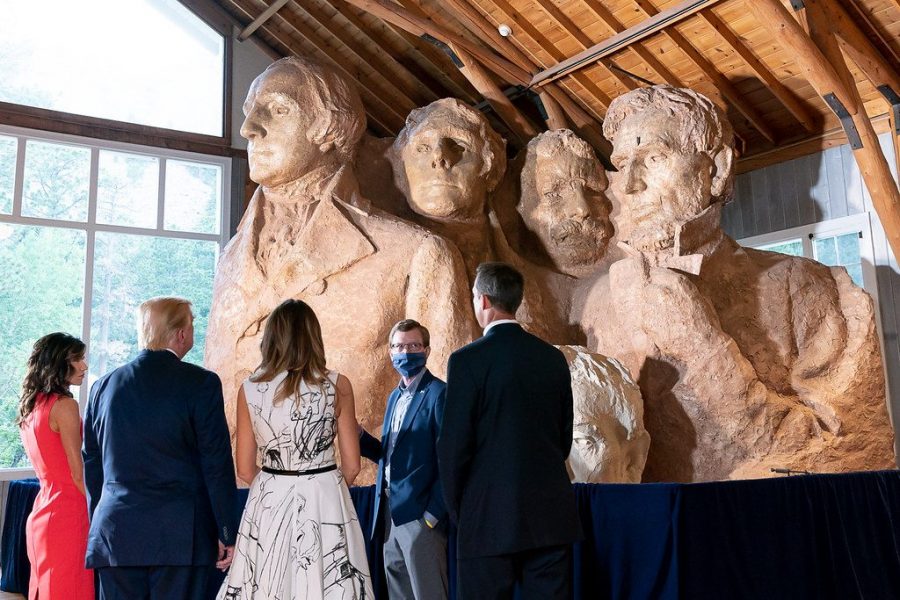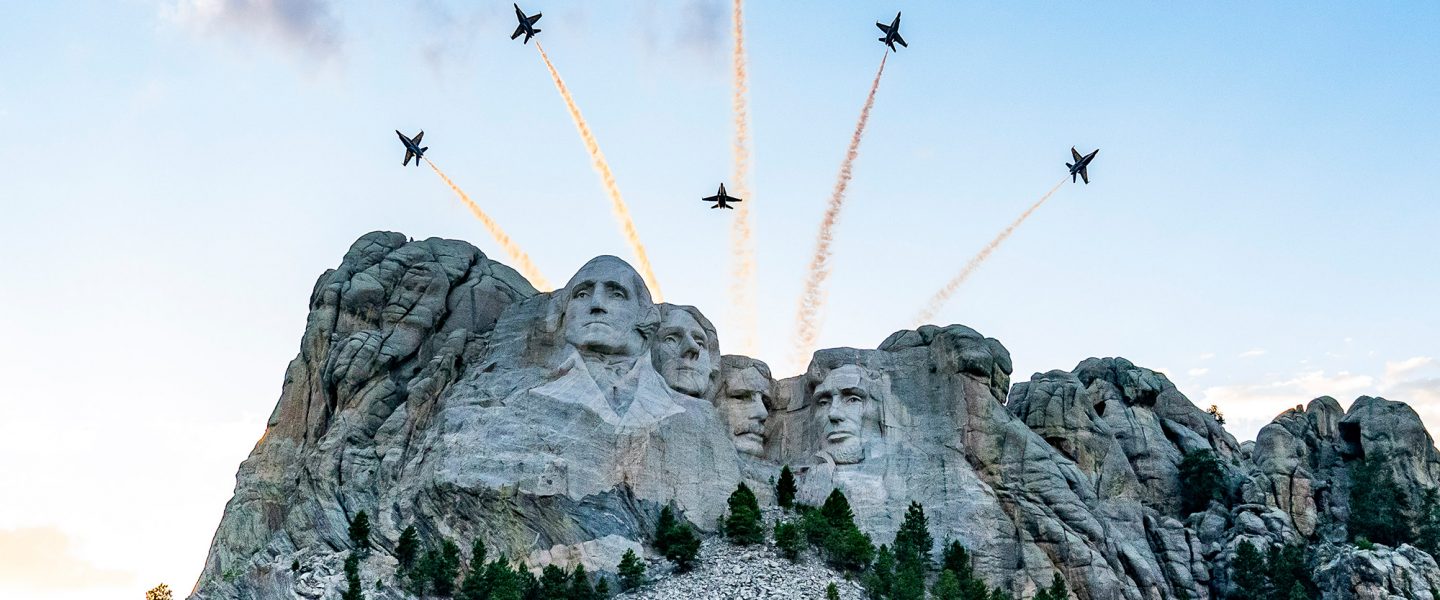Remembering American Disasters
The biggest threats to America used to come from terrorist groups outside the country; now they are coming from inside the country as well.
|
Listen To This Story
|
On the anniversary of the 9/11 terrorist attack that took down the Twin Towers of New York’s World Trade Center, I was driving along Interstate 95 from Philadelphia to Washington, DC, to have lunch with a friend. I turned on the car radio somewhere in Maryland and listened to C-SPAN solemnly read out the names of the nearly 3,000 Americans killed in an attack that took place before most Americans now in their early 20s had been born. C-SPAN followed their mournful reading with an excerpt of Joe Biden’s lackluster commemoration of the event delivered to American troops in Nome, AK, on his return from Vietnam.
When Biden had finished, C-SPAN suddenly switched to a more contemporary topic — namely excerpts of ex-President Donald Trump’s campaign speech several days earlier at a rally in South Dakota.
Outrageousness and political incorrectness are a normal part of the Trump brand, but this speech was not only divisive; it sounded disturbingly incoherent, even demented. I wondered why C-SPAN had bothered to broadcast it on the anniversary of 9/11. The rally had taken place several days earlier. Then it occurred to me that either an alert editor at C-SPAN or a computer algorithm — you never know, these days — might have decided it could be a good idea to alert the nation’s capital to the kind of thing that Trump has been putting out in the hinterland. Al-Qaeda is long gone or at least in the background as a threat to national security. Trump is still here and very present.
Trump’s speech at the self-styled South Dakota Monumental Leader’s Rally came across, not surprisingly, as a remarkable exercise in modern-day rabble-rousing. As the venerable Supreme Court Justice Oliver Wendell Holmes once remarked, “Freedom of speech is not freedom to cry fire in a crowded theater.” Trump passed that point long ago.
In Rapid City, SD, Trump launched into his speech by claiming credit for previous fireworks displays at the Mount Rushmore National Monument, in which the images of Washington, Jefferson, Teddy Roosevelt, and Lincoln have been blasted into the side of a mountain.

Photo credit: Trump White House Archived / Flickr
According to Trump, “Marxist and Communist Democrats” had put an end to the fireworks. Sure, the National Park Service had warned that the fireworks risked unleashing uncontrollable wildfires, but, “Hey,” Trump said, “I told them all it’s all rock and stone and that doesn’t catch fire.” Forget about the pine forests that surround the monument. He went on,
I fiercely defended our American heroes [the statues on Mount Rushmore] from the Marxists and Communist maniacs who were trying to blast them off the mountain. They would have done that. Yet today, under Joe Biden, the Marxists, fascists and Communists are not just tearing down statues, they are looting our middle class, mutilating our children, desecrating our Constitution, and perverting our military. Our military used to be nice. It defeated ISIS, and now it is WOKE.
Continuing in a similar vein concerning three years of the Biden administration, Trump said,
It is horrible to tell you what happened, but you know what happened, watch the newscasts, which by the way, if you look at ABC, CBS, CNN, you look at MSNBC, they are evil! They are a wing of the Democratic Party. … All of this horror and Joe Biden traveling around the country pretending he’s an economic genius. He is actually an economic arsonist. Bidenomics incinerating American wealth at a level never seen before. It is an inferno of inflation, taxation, value and submission. We submit. We are submitting to China. … We are taking tons of garbage, because China dumps their garbage in the Pacific and the tide flows it into Los Angeles. They have to participate because it blows over three or four days so what good does it do for us to destroy our businesses by putting controls all over the place.
This was not just a rant; it was almost unintelligible. It had the confused rhythm of a drunk truck driver. The audience loved it.
The question in my mind was why Trump had picked South Dakota to stage what he obviously considered to be an important rally. The state is hardly a major player in national politics. It has two senators and one congressman. The entire population, around 900,000 people, is slightly smaller than that of the city of Austin, TX.
Introducing Trump, South Dakota’s governor, Kristi Noem, who is in her early fifties, remarked that someone had asked her the same question: Why would Trump even bother to campaign in a state that everyone else considered off the radar? “That conversation quickly went south,” Noem said, laughing, but the question was still there.
Both the New York Post and the London Daily Mail tabloids have reported that Noem had been having a year-long affair with Trump adviser and former campaign manager Corey Lewandowski. A more accurate answer might be that while South Dakota does have the fifth smallest population of any state, that population is 82.6 percent white, pays no state taxes even though citizens receive roughly $10,600 per capita in federal funding, has very little contact with the outside world, and loves its guns (according to World Population Review, 55 percent of South Dakotans own a gun; there are 21,000 registered guns in the state, which ranks ninth in the country for gun ownership). All that fits the Trump profile perfectly. Throughout his speech, Trump kept asking why the TV cameras didn’t focus on this excited crowd crammed into an auditorium, even if it was in the middle of nowhere.
The rally was ostensibly organized by the Republican Party, but while Noem gushingly endorsed Trump, the state’s all-Republican Congressional delegation — Sens. John Thune and Mike Rounds and its single House representative, Dusty Johnson — decided to give Trump and the event a pass.
The crowd didn’t seem to care about that. It struck me that Trump’s delivery sounded like someone who had barely had an eighth-grade education. Then it occurred to me that that might not be accidental. In fact, it is part of Trump’s genius. These were his people, and he was speaking to them in their language. Trump is nothing if not an accomplished street hustler.
Some people still think that Trump won the 2016 election on a fluke. The US population had long been evenly split between conservatives and liberals. Hillary Clinton was an accomplished secretary of state, but not an effective presidential candidate. Trump had unexpected help from a Kremlin-based misinformation campaign, a conflicted head of the FBI, and Steve Bannon, who had the brilliant insight that given some bizarre eccentricities embedded in the Constitution, if you could swing a mere 100,000 votes in a few swing states, you could tip the balance in your favor, at least as far as the Electoral College was concerned.
Bannon figured that you could get those extra votes by going to a part of the electorate that everyone had previously written off. It was the part that Hillary Clinton injudiciously described as “the deplorables.” Some Washington pundits call it the “lunatic fringe.” These people had always been there in one form or another since before the American Revolution. They were the folks whose hysteria led to the Salem witch trials, who thought that Sen. Joe McCarthy’s rabid anti-communist tirades made sense, or who believed that Barack Obama was born in Kenya, not Hawaii.
Today, these are the front-line MAGA extremists who are not only defending their right to open-carry military grade automatic rifles but are joining various militia groups across the country. Steve Bannon knew where to look, in part from his previous experience running a company that sold video games out of Hong Kong. The experience had put him in contact with numerous groups of angry young white men across the US who sought an outlet for their frustrations in video games like Call of Duty: Modern Warfare and Mortal Kombat — just the type to resonate with Trump’s message. Trump, after his so-called reality TV experience with The Apprentice, knew how to appeal to them. As Steve Bannon famously put it, the Democrats came prepared for a pillow fight. Republicans knew it would be a knife fight.
The first real casualty of Trumpism is the Republican Party. No longer the ‘Grand Old Party,’ extremists have increasingly distanced the party from what most Americans actually think.
Trump’s rise coincided nicely with growing concerns on the part of some of America’s wealthiest individuals, a number of them inheritors of the massive fortunes accumulated by the robber barons of the 19th century and assorted speculators who profited from the early days of the American industrial economy when there was little taxation and practically no regulation. These were the people who called Franklin Roosevelt “a traitor to his class,” and who condemned the New Deal — which enabled the country to survive the Great Depression — as a socialist plot to cut into their privilege. The Great Depression and World War II forced them into the background, but when Ronald Reagan became president, they began to reassert political power. The Republican Party, originally the antislavery party but long since transformed to the political home of unapologetic plutocrats, seemed like the ideal vehicle to promote their point of view.
The trifecta of dark money, Trump’s populism, and the increasingly vociferous support of the crazies who felt legitimized by Bannon’s strategy, was enough to get Trump sufficient Electoral College votes to win the White House in 2016, even if he failed to capture a majority of the popular vote. Like most deals with the devil, however, it did not take long for things to go wrong. In order to hang on to his following, Trump, as evidenced by the performance in the Mount Rushmore state, was forced to become increasingly extreme and to look for pockets of support in odd places until, finally, he ceased to make even a semblance of sense and simply sounded demented.
The first real casualty of Trumpism has been the Republican Party. Extremists have increasingly distanced the party from what most Americans actually think. Continuous coverage on propaganda outlets such as Fox News and rallies like the one in South Dakota give the impression of a substantial following, but the truth is support for the party is shrinking, especially among younger voters. Its insistence on denying the diversity of America and selling itself as a bastion of white, Protestant, and northern European stock means that it will increasingly be a minority party. Its only hope to gain and stay in power is to turn Americans against Americans, to inflame the passions of just enough voters to fear and, yes, hate enough of their compatriots to keep securing a majority of the Electoral College. It’s a strategy that worked in 2016 and may well work again in 2024.
After C-SPAN had finished broadcasting Trump’s speech in South Dakota, it went back to reading the names of those killed in 9/11. I remembered an intelligence briefing on terrorism I received when I was still a soldier in the US Army. “Terrorism cannot achieve a military victory,” the instructor said, “Its goal is to frighten the victim into destroying himself.” As FDR put it in the darkest days of World War II, “The only thing we have to fear is fear itself.”


